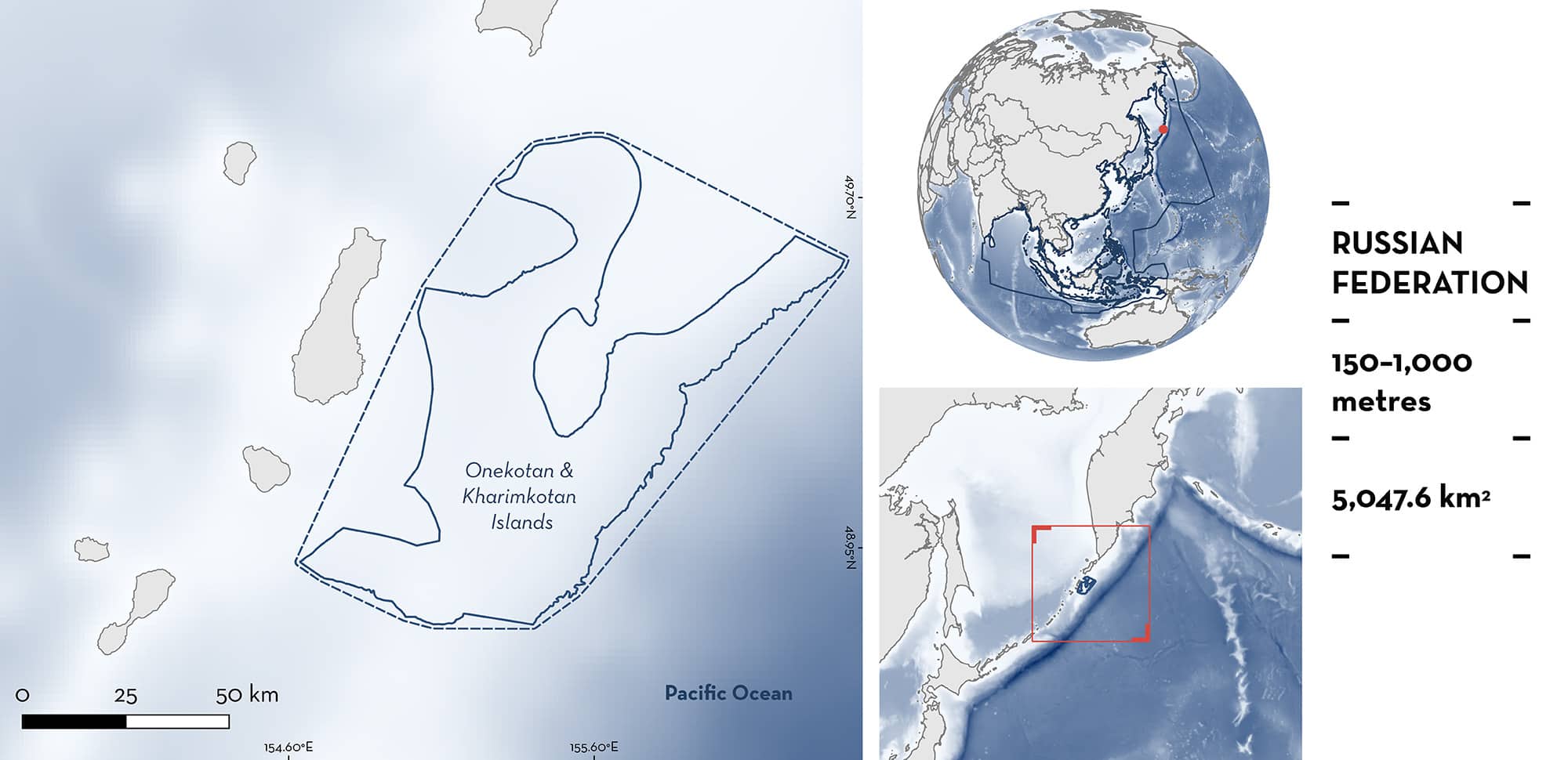ISRA FACTSHEETS
ISRA FACTSHEETS
ASIA REGION
Onekotan & Kharimkotan Islands
Summary
Onekotan & Kharimkotan Islands is located in the Northern Kuril Islands, in waters of the Russian Federation. The area is characterised by a very narrow continental shelf and a relatively wide slope with multiple underwater canyons. Within this area there are: undefined aggregations (e.g., Whitebrow Skate Bathyraja minispinosa).
Download factsheet
Onekotan & Kharimkotan Islands
DESCRIPTION OF HABITAT
Onekotan & Kharimkotan Islands is located in the Northern Kuril Islands and is part of the Sakhalin Oblast in the Russian Federation. It is part of the seventh standard area for averaging biostatistical information during ongoing monitoring studies in the Northwest Pacific Ocean (Shuntov et al. 2014). The area includes both islands and adjacent waters of the Fourth Kuril Strait. Onekotan is the second largest island in the northern Kuril Group after Paramushir and extends for 43 km while Kharimkotan extends for 13 km (Aprodov 1982). The area is characterised by a very narrow continental shelf and a relatively wide slope with multiple underwater canyons.
There is a quasi-stationary anticyclonic eddy influencing the area from the south of Paramushir Island to the underwater plateau southeast of Onekotan Island (Orlov & Ul’chenko 2012). Sea bottom temperatures range from -0.5 to 4.5°C annually (Orlov & Ul’chenko 2012).
This Important Shark and Ray Area is benthic and subsurface and is delineated from 150 m to 1,000 m based on the depth range of the Qualifying Species in the area.
CRITERION C
SUB-CRITERION C5 – UNDEFINED AGGREGATIONS
Onekotan & Kharimkotan Islands is an important area for undefined aggregations of two ray species.
Skates are known to aggregate with temporal changes related to sex and life-stage segregations (Swain & Benoît 2006; Frisk 2010; Hoff 2016). Skates usually aggregate in high density areas where large catch quantities of these species occur (Bizzarro et al. 2014). Here, catch-per-unit-effort (CPUE, individuals/km2) can be used as an indicator of aggregations for numerous skate species (Orlov & Volvenko 2022). Scientific surveys using benthic trawls between 2010–2021 showed that aggregations of Whitebrow Skate and Mud Skate regularly occur in Onekotan & Kharimkotan Islands (Orlov & Volvenko 2022; Orlov & Volvenko unpubl. data 2023). CPUE for each species was calculated based on the area swept by survey trawls (Volvenko 2014; Orlov & Volvenko 2022).
This area holds the second largest abundance of Whitebrow Skate (mean: 82 individuals/km2, max: 566 individuals/km2) in Russian waters of the Northwest Pacific (Orlov & Volvenko 2022; Orlov & Volvenko unpubl. data 2023). Individuals of this species were caught in other areas of the region but in minimal numbers compared to Onekotan & Kharimkotan Islands. The largest abundances were found in the boreal autumn at depths of 148–950 m with multiple individuals caught in a single haul. More information is needed to confirm the nature and function of these aggregations.
This area holds the second largest abundance of Mud Skate (mean: 275 individuals/km2, max: 2,308 individuals/km2) in Russian waters of the Northwest Pacific (Orlov & Volvenko 2022; Orlov & Volvenko unpubl. data 2023). Individuals of this species were caught in other areas of the region but in minimal numbers compared to Onekotan & Kharimkotan Islands. The largest abundances were found in autumn, at depths of 100–564 m (Orlov & Tokranov 2010; Orlov & Volvenko 2022) with multiple individuals caught in a single haul. Between 1992–2002, this was also the main catch area for Mud Skate, especially during summer and winter (Orlov & Tokranov 2010). In that period, individuals were mostly caught between 250–500 m at temperatures of 2.5–3.5°C. Some individuals that may be neonates or young-of-the-year (<20 cm total length) have been reported in the area (Orlov & Tokranov 2010), but more information is needed to confirm their regular and contemporary presence, as well as the nature and function of the aggregations.
Download factsheet
SUBMIT A REQUEST
ISRA SPATIAL LAYER REQUEST
To make a request to download the ISRA Layer in either a GIS compatible Shapefile (.shp) or Google Earth compatible Keyhole Markup Language Zipped file (.kmz) please complete the following form. We will review your request and send the download details to you. We will endeavor to send you the requested files as soon as we can. However, please note that this is not an automated process, and before requests are responded to, they undergo internal review and authorization. As such, requests normally take 5–10 working days to process.
Should you have questions about the data or process, please do not hesitate to contact us.


